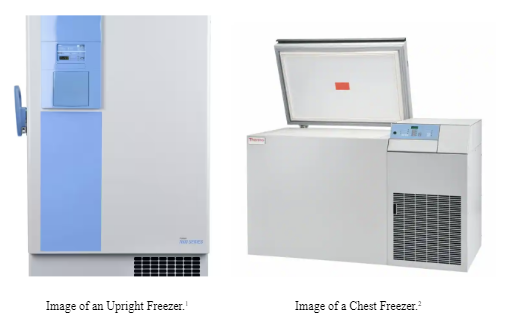Chest vs. Upright Freezers: Which is More Efficient in a Lab?

How are Chest and Upright Freezers Different?
There are a few distinct features in each freezer. One being their orientation. An upright freezer has a door on the front that must be pulled open, and it extends left to right. When installing these, one must take this distance that it needs to open, into consideration. A chest freezer opens from the top, and has a much wider base . The way that these freezers open also impacts their energy usage. When the door is opened in an upright freezer, large sums of cold air are let out and heat is let in which draws more energy to re-cool the system. Whereas with a chest freezer, there is less cold air loss when the door is opened, the larger depth of the freezer also helps reduce cold air loss, resulting in less energy being needed to restabilize the cold temperature in the freezer. On a different note, chest freezers have around 20% more storage capacity than upright freezers, so they are able to hold a more significant amount of materials . The only downfall of this is that the organization of materials is much easier within an upright freezer, which the chest freezer does not have due to the dimensions and the way it is built. A chest freezer tends to be much harder to clean due to the limited ability to organize materials. The upright freezers also utilize less floor space as they are much thinner than the chest freezers which have a much larger width, but the upright freezers also have a larger height which must be taken into account as well. The last major difference between the two is their average lifespan. Chest freezers often have a longer lifespan than upright freezers as they have less issues with overheating and leakage. Upright freezers have a lifespan about 5 years shorter than a chest freezer, From all of this information, which one continues to be more efficient within a lab space?
Which Freezer is More Efficient in a Lab?
Based on the differences described above, we determined that a chest freezer is the more efficient choice. They are more energy efficient than upright freezers, and allow more energy to be retained and not put to waste. According to Eppendorf and their products, “the 570 L upright freezer needs 13.3 Wh/ day and liter of cooled volume whereas the 660 L chest freezer needs 12.3 Wh/ day per liter of cooled volume.”4 The data table below shows other energy usage calculations for different types and brands of freezers. Another main benefit of the chest freezer is the lifespan.. The chest freezer doesn’t need to be replaced as frequently, which decreases the total cost spent by a lab. Chest freezers also have more storage space than upright freezers, which results in less need for other storage spaces within a lab, optimizing energy efficient storage. So, the better choice for a more efficient freezer within a lab ends up being the chest freezer! This stems from their energy efficiency, their optimization of storage, and their longer lifespan within a lab!
Sources:
1https://www.thermofisher.com/order/catalog/product/7400V
2https://www.fishersci.com/shop/products/cryogenic-storage-chest-freezers/1398661
3https://www.spencerstv.com/blog/upright-vs-chest-freezers#chart
4https://handling-solutions.eppendorf.com/sample-handling/storage/detailview-80-c/news/footprint-versus-efficiency/
Alexandra Drobny is an undergraduate intern with the UCSB Sustainability Office. The above material has not been reviewed by a UCSB faculty member and is not endorsed by UCSB or the UCSB Sustainability Office.